On where we grew up, and what it does to us...
Today was a weird day. It didn’t start out that way, but I didn’t wake up expecting the day to be normal, or weird, or anything. I’m laid off from the summer job, and there’s still a month or so before school begins, so I’m at the mercy of whatever comes my way.
I did actually have something planned; kind of an exception in the last week or so. Today I went into work to discuss some potential software on universal gravity with St. Francis’s IT guy. Went well, nothing fancy. I downloaded the trial of the package I wanted, and I futzed with it a bit. I liked it, I guess; well enough to give it a try this year.
Walked out to the parking lot, and as has been the case for the last month, in these strange dry days of constantly above-85 and few if any clouds, the bike was waiting for me.
[This in not another motorhead-style posting, as the last few have been, so you may read on, if you so choose, confident in the knowledge that I will not mention carburetors or drifting or wheelies or broken radiators. Nor will I post pictures of various things at 100 mph. Well, maybe one.]
So I climbed on and fired up the old beast, and I turned left out of St. Francis’s parking lot, and my brain switched on its little mental cruise control and I just went along for the ride. I found myself eventually in Winfield.
I don’t really have a hometown. I was born in Lombard; I lived in Winfield for a while, and I lived in Naperville for a while (though I try not to admit it—I hate that town) and I lived in DeKalb for awhile, and I’ve lived in Plainfield for awhile. I guess, though, that Winfield is the closest thing I have to a hometown, and I would move back there if I could.
I spent a lot of time just roaming the streets, the Moose popping and snarling and generally scaring the bejeezus out of pedestrians and motorists alike. Winfield is a small town, and it’s pretty quiet. It has a downtown area of sorts, but unlike most small towns like Hinckley or Sandwich or even Somonauk, where the downtown area is at least a couple of blocks long, Winfield’s is about a third of a block long, and it consists mainly of a small strip mall and a bar. Bikes are not a part of the overall Winfield picture. People stare. I did get back to my motorhead roots a bit by taking a nice high-speed blast up Summit Hill. 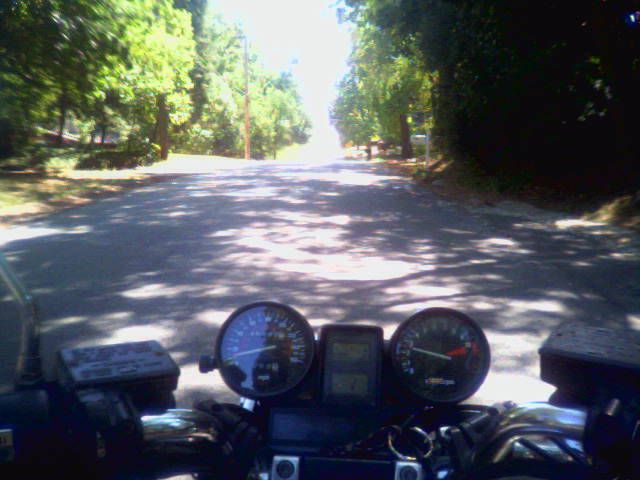
Summit is spooky going up, and even spookier going down. (It's important to note that the top of the hill is higher than it might appear in this snappy-snap, due to a trick of the light. The hill's actually in two stages--look about a third down from the top of the picture and you'll see it.) This is, incidentally, the hill I mentioned in a previous blog that my brother went down every day in his (soon to be my) MGB, catching enormous air and tearing chunks out of the asphalt on the landing as the suspension momentarily collapsed. You don’t get nearly as much air going up as you do going down, but today I got a little.
I guess the thrust of this particular blog came about as I was aimlessly roaming the streets, checking out the house I lived in and the schools I went to (Winfield has two—St. John the Baptist and Winfield Elementary—and I went to both-) and I realized how the places we live and grow shape the way we look at the world. In the grand scheme of things, I only lived in Winfield a little while, but of all the places I have lived, it seems that Winfield has colored the images in my head and my heart with the brightest crayons.
For example, in stories, or in songs, you often hear people describe how they were standing on the corner. In my head, whenever I hear that phrase, the corner I see is this one. 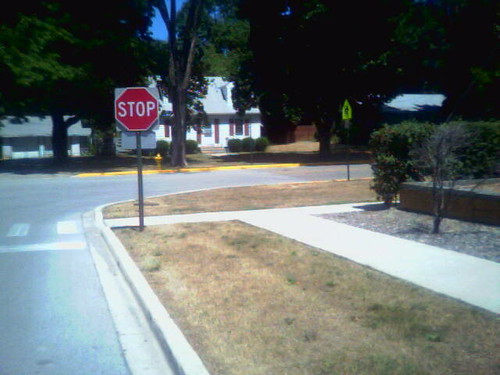
It’s nothing special; just a little corner in a small town next to a public elementary school. In my head, though, this corner is always at early evening in the summertime, where the sun is still up but mostly obscured by buildings or trees, putting a filter on the last minutes of daylight and softening the edges between light and shadow. I am standing on this corner, and usually I am looking at the little house across the street. I never knew the names of the person or persons that lived in that house when I called Winfield home, and I don’t now, but in my head I am standing on the corner waiting for someone to come out, and that person is a dear friend. I don’t know who that person is. Maybe someday I will.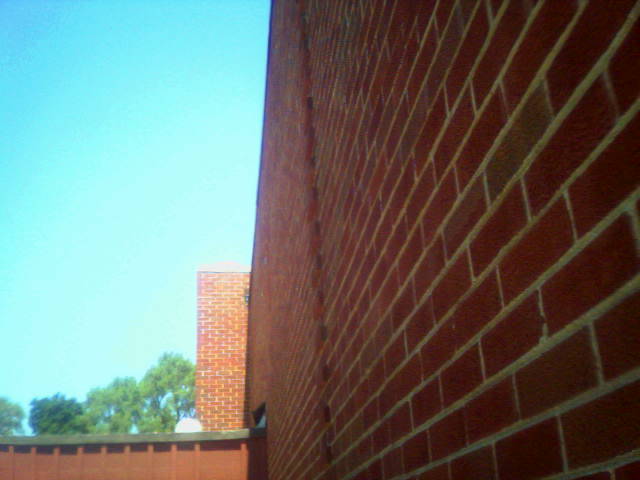
Whenever I hear the word wall, this is the wall I see. It is the west wall of the gymnasium at Winfield Elementary, and it forms a corner with the rest of the building right here. I got the shit beat out of me a few times in that corner, where there are no windows. I also went back there a few times with friends at recess, just screwing around, and one of the things we always did was try to climb the wall using this odd column of bricks that poke out just a little. None of us ever succeeded.
You know that noise a hammer makes when it hits an anvil? If you can’t get a handle on it right away, listen to The Beatles’ “Maxwell’s Silver Hammer” and you’ll get the gist. Whenever I hear that noise, I see this: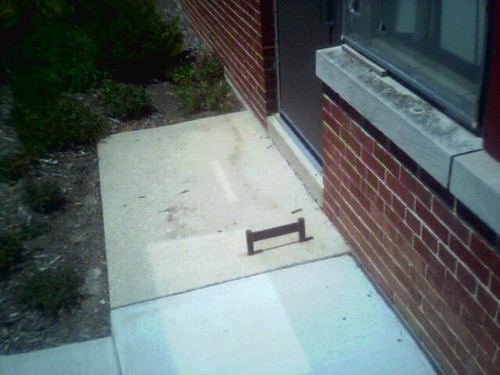
Winfield Elementary has just about the same number of doors as any small-town public elementary school, I’d wager, but something odd is that each door has one of these—a combination boot-scraper and doorstop. They’re bad to be around when you’re getting your ass kicked, because once you’re on the ground, it’s pretty easy for your assailant to drag you over to one of these and start beating your head against it. But, when you’re bored, and all the swings are taken on the playground and you don’t want to wait in line for the slide and there aren’t any foursquare balls left and there’s still fifteen minutes or so left until recess is over, you can occupy your time quite easily with your friends Brian York, Danny Gray and Kevin Muto throwing rocks at one of these. The noise they make on the rare occasions they hit sound a lot like that.
Near the downtown area is a building on another corner. It’s a weird little building, and it currently houses a dentist. The building is constructed into the side of the hill that rises to meet the railroad tracks. What’s weird about the building is that it has a sidewalk along the front of it that is perfectly level, though the street is not. Even stranger is the fact that, when the sidewalk reaches the end of the building, it just stops, hanging out over three feet or so of empty space. 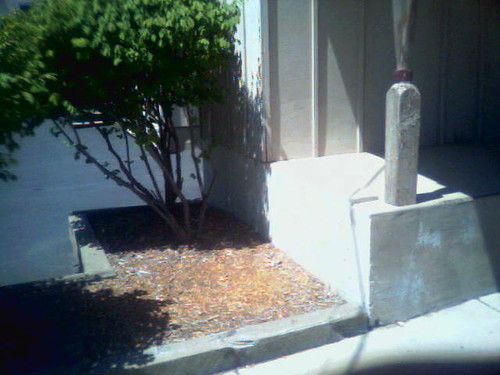
There used to be gravel at the base of this strange concrete cliff, instead of the nicely-manicured mulch beds there now. I once watched my brother attempt to jump his Murray off this truncated sidewalk. He hit the gravel and wiped out in an ugly way. He went off crying while his friends laughed. I gave them the finger and followed my brother home.
Winfield, though small, has its good sides and bad sides, like any town. I did not grow up on the good side, though I wouldn’t trade where we lived for anything. Most of my friends lived on the other side of the tracks, where the houses were nice and neat and backyards didn’t flood when it rained and raccoons didn’t live in the attic and snakes and woodchucks in the basement. If you crossed the crick in back of my house, you got to the scary side of town—ramshackle houses that backed right up to the tracks. All the bullies at school seemed to live on this street—Beecher Street. It dead-ended in a snarl of woods that also backed up to the Boy’s Correctional Facility at the DuPage County Complex on County Farm Road. My parents warned my brother and I to stay out of these woods. We obeyed--most of the time.
Even weirder was the fact that, right after the houses on Beecher Street ended and before the woods began, there was a scary industrial building, one story tall and about a quarter of a block long, that reposed back there like a sleeping wolverine. It was menacing in a dormant kind of way, because businesses came and went and never seemed to stay for long, leaving the building in what seemed to be a suspended state of decay. My parents told me to stay away from this place as well, because a lot of the older kids from this part of town came back here to do whatever drugs they’d found in their older siblings’ underwear drawer or drink the beer they’d persuaded some poor sap to buy them at the Winfield Liquor next to the bar downtown. They’d go in the alleyway between the building and the ten-foot-tall retaining wall that abutted the railroad embankment. I took a picture of this alley, but for some reason it didn’t come out.
That alley is still a scary place, and though I’m a thirty-two-year-old man (fuck, it feels weird just saying that) I still see that alley through the eyes of an eight-year-old. When you hear someone telling you how they got chased down some dark alley, I couldn’t have any less idea what alley you see in your head, but this is the alley I see in mine. It was always a dare among my friends—who’s brave enough to ride his bicycle all the way through from one side to the other? I did it a few times, shitting my pants the whole way. Even the graffiti was freaky—not spray paint, but somehow burned into the bricks in dagger-slash letters. I rode my bike through there today, and I made it maybe halfway through before I grabbed a handful of throttle. I couldn’t help it. Call me a candyass. And maybe if you visited this part of town today, or if you happen to live on that street, you’d see it a completely different way, and maybe the houses there are nicer and have been fixed up and the bullies have moved away and nobody does drugs in the alley behind the building and all the graffiti has been sandblasted and it’s all just as nice and innocent as you could hope for. My brain, however, has colored it a different way, and it seems that you can’t erase those colors, the ones in your head and in your heart; all you can do is wait for them to fade enough to use another color.
I went down my old street—Liberty Street. It’s one street over and parallel to Beecher, and it’s a dead end too; but unlike Beecher it dead-ends into a meadow. If you came up to me on the street and said that word, meadow, this one is the one I see. It was kind of neat, being able to walk out your front door and turn left and be in a meadow, even if it did flood when it rained.
My house was the last one on the left. Unlike a few others on Liberty, mine is still standing. Next door to my house used to be a little white house. An elderly couple, the Ziekerts, lived there. She was very nice and used to bake my brother and I cookies, but he was a total crabass. He died when I was ten or so, and from then on I mowed her lawn in the summertime. Strangely, and another example of the weird way Winfield lays concrete, the Ziekerts’ house was the only house on our street to have a sidewalk. Mine didn’t, and the house on the other side of Ziekerts’, the Wold’s, didn’t. What this meant is that the sidewalk started and ended in Ziekerts’ tiny yard, a three-inch-high cliff of concrete on either side. I learned the hard way that you cannot drive a lawn tractor with the blades turning over this cliff, or you will bend the holy fuck out of the blades on the sharp corner where the right angle of the sidewalk gives way to grass. The sidewalk is still there, though the house is only a ghost of a memory, and three of the corners are still sharp. One is nicely rounded.
Mr. Ziekert put a rock on either side of his driveway. One was pretty big; the other was fairly smooth, and over time, sank just deep enough into the ground to become a fairly decent jump for a kid on a BMX bike. It became for me a daily tradition on the way to school; I’d jump the rock and vault off the end of the sidewalk. When Mr. Ziekert was alive, he’d cuss me out whenever he saw me doing this. I’d give him the finger and keep right on pedaling. The Ziekerts are gone and their house is gone, but the rock, like the sidewalk, is still there. 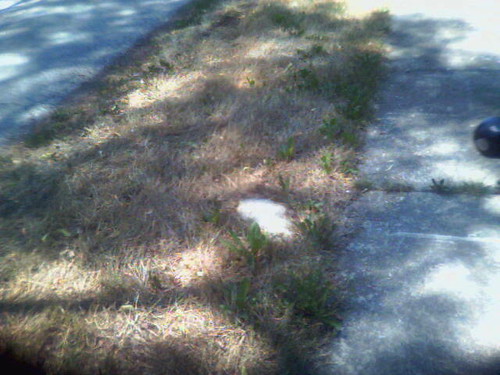
I tried jumping it today on my bike, but it wasn’t the same, somehow. And anyway I went a lot farther into the Wold’s lawn than the last time I tried it twenty years ago. I don’t remember leaving tire tracks that frickin’ deep, either.
Liberty Street intersects with Church Street in a T. Church Street is aptly named, because at the intersection of Liberty and Church there is a church. Two of them, actually, but they both belong to the Parish of St. John the Baptist; the new church, built in 1983, in all its angular new-Catholic newishness; and the old one, built in 1906, and as gothic and glorious as you could wish for. I watched the new one being built, and on a dare I ran a lap around its inside perimeter after climbing through a window, only to find when I climbed back out that my asshole friends had absconded with my bicycle. But when you say the word church, it is the old one I see, with its gothic stained glass windows and its steeple complete with a cross that, up until about five years ago, had a pronounced lean.
I went inside and sat down near the back. I know this church like the back of my own hand, though it has been over fifteen years since I’ve sat foot in it. I know each creaky board, and I know that the sacristy on one side of the altar and the altar boys’ prep room on the other side are linked by a creepy tunnel that runs behind the altar, where the linoleum is peeling off the floor in big chunks. I know that the stairway to the balcony is blocked by a gate, but the gate is rarely locked, and even if it is, it’s easy to tickle. I know that the old pipe organ in the balcony, directly underneath the steeple, still works great, and I know where the power switch is, and when you flip it, the blowers that provide the air turn on with a lovely whoosh. I know these things, but I had forgotten them all until five seconds before, when I walked in. 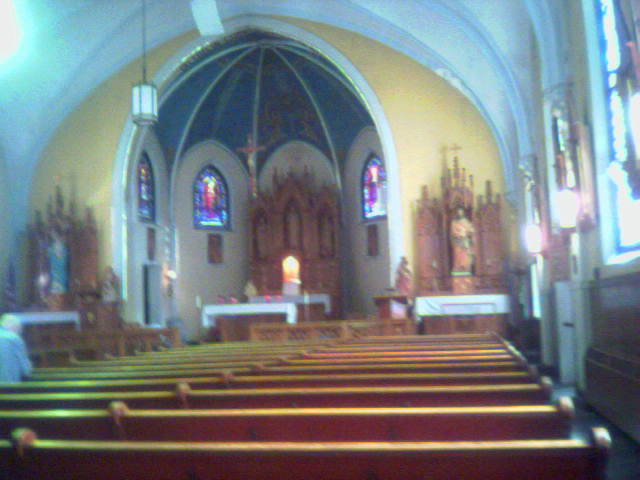
I’m sorry the picture is so crappy; I wish it had turned out better, because it’s really the inspiration behind this whole blog. What you see is what I see from the very rearmost pew in the right rear of the church. When they built this guy in the early 1900’s, they did not know the meaning of the word restraint, and I could not be happier for it. The picture doesn’t show all the neat little details, but if you look in the area above the altar, you’ll see what I wanted to show you. Just above the altar, the wonderful vaulted ceiling is painted a deep blue. It is emblazoned with gold stars, and at the very back, two seraphim are doing homage to the Lamb. I didn’t show you this to throw my faith in your face. I showed it to you because, in my head, this ceiling is what I see when I hear the word splendor. That word is one of my favorite words, because of the image it paints.
 When all is said and done, I'm still just a putz.
When all is said and done, I'm still just a putz.
1 Comments:
Hi, coming here by way of the Kevin's blog.
What a great post.
I particularly liked how you tied in ideas/images from simple words or song lyrics to what you actually see based on your childhood. And you showed us with photos. Cool.
It's amazing how much we can remember about an old place upon stepping into again. Your familiarity with all the workings of the church after being away for so long gave me goosebumps. That's a beautiful idea of 'splendor' to have. My husband and I were married in a Catholic church very similar to that one, from about the same era. The ornate design and the color is so awesome. There is life in it.
By Mary, at 3:46 PM
Mary, at 3:46 PM
Post a Comment
<< Home